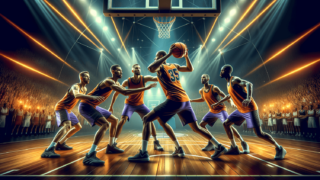
How to Become a Better Rebounder in Basketball?
Written by: Basketball Universe
Last updated:

Rebounding is an essential skill in the game of basketball, distinguishing the true difference-makers on the court from the rest. It’s no wonder that you, oh curious reader, seek the mastery of this powerful facet of the game! Welcome to our in-depth guide titled ‘How to Become a Better Rebounder in Basketball.’ In this fun and professional blog post, we’ll delve into the secrets behind the art of rebounding, exploring tips, techniques, and mindsets that will elevate your dominance on the boards. So, lace up your sneakers, and let’s unlock the untapped potential within you to become the most ferocious rebounder on the hardwood!
How to Become a Better Rebounder in Basketball?
To become a better rebounder in basketball, focus on improving your positioning, anticipation, and physical attributes like strength, leaping ability, and agility. Develop a solid box-out technique, learn to read the trajectory of the ball, and cultivate an aggressive mindset to consistently secure rebounds. Additionally, studying and learning from top rebounders will help enhance your understanding of rebounding strategies.
Understanding the Science of Rebounding
Before we jump into the nuts and bolts of improving your rebounding skills, it’s crucial to grasp the underlying principles. In basketball, a rebound occurs when a player retrieves the ball after a missed shot. Rebounds can be classified as offensive (grabbed by the attacking team) or defensive (snatched by the defending team). Mastering the fine art of rebounding will not only increase your personal stats but also contribute significantly to your team’s success by generating second-chance opportunities and limiting the opponent’s possessions.
Positioning: The Key to Dominating the Boards
One of the most critical factors in becoming a better rebounder is learning how to position yourself effectively on the court. Smart positioning can help you outrebound taller or more athletic players by being in the right spot at the right time.
Perfect the Art of Boxing Out
A well-executed box-out is a fantastic way to gain an advantage when battling for rebounds. The main objective of boxing out is to create a barrier between your opponent and the hoop, allowing you to have a clear path to the ball. To practice your box-out, follow these steps:
- Locate your opponent as the shot goes up, and quickly establish contact.
- Bend your knees and lower your hips, keeping a wide stance for balance and leverage.
- Once contact is made, extend your arms out to the side, using your body as a wall to keep the opponent out of rebounding position.
- React quickly to the ball by moving laterally and vertically to outwork your opponent.
The Power of Anticipation: Reading the Ball’s Trajectory
Developing the ability to anticipate where the ball will land on a missed shot can give you a significant leg up in the rebounding game. Consider the following tips to improve your basketball anticipation skills:
- Watch the flight of the shot, and note if it’s too long, too short, or on target.
- Understand that long shots typically produce long rebounds, while short shots are more likely to generate shorter, softer rebounds.
- Track the ball as it enters the hoop zone, noting its angle and speed to gauge where the rebound is likely to be.
- Be aware of your surroundings, avoiding collisions with teammates or allowing opponents to sneak in and snatch the ball.
Enhance Your Physical Attributes
While positioning and anticipation play pivotal roles in rebounding, there’s no denying that some physical attributes can give you an edge. To boost your rebounding prowess, consider improving these aspects of your athletic profile:
Strength and Conditioning
A powerful and well-conditioned athlete can often outmuscle their opponents when fighting for rebounds. Engage in regular strength training sessions, focusing on exercises that target your legs, hips, back, and core. Plyometric exercises, such as box jumps and squat jumps, can also help enhance your explosive power, which translates to better leaping ability to grab those coveted rebounds.
Agility and Mobility
In addition to strength and power, agility and mobility are indispensable attributes for a top-notch rebounder. Work on your lateral quickness through drills and exercises, such as side shuffles, lateral lunges, and cone drills. Enhancing your mobility, especially in the hips and ankles, will promote faster reaction times and enable you to contort your body to secure rebounds in tight situations.
Hand-eye Coordination
Excellent hand-eye coordination is crucial for securing the basketball amidst a crowd of players. To develop this skill, include activities like juggling, reaction ball drills, and various dribbling exercises in your training routine. The better your hand-eye coordination, the more likely you’ll be able to snatch rebounds out of the air, even when contested by your opponents.
The Mental Aspect of Rebounding
Beyond the physical and technical components, rebounding success stems from a certain mindset—a relentless hunger to out-hustle and out-grit your opponents. To cultivate this mental tenacity, try the following strategies:
Hunt for Every Ball
Approach every missed shot as a potential rebound opportunity by staying on your toes and always remaining engaged in the play. Bring relentless energy and hustle to your game, refusing to accept defeat in any rebounding battle.
Embrace the Dirty Work
A productive rebounder does more than make highlight-reel plays—they’re willing to dive for loose balls, battle in physical skirmishes, and sacrifice their bodies to protect their teammates. Embrace these less glamorous aspects of the game and take pride in the indispensable role you are playing in your team’s success.
Study the Greats
Many of the game’s top rebounders possess a keen understanding of both the art and science of controlling the boards. Studying film of legendary rebounders like Dennis Rodman, Charles Barkley, and Tim Duncan can provide valuable insights into positioning, box-out techniques, and timing that can be integrated into your own game.
Drills and Tips for Improvement
Now that we’ve discussed the foundational aspects of rebounding excellence, let’s explore some specific drills and tips to reinforce these concepts and help accelerate your growth:
Basketball Rebounding Drill: The Mikan Drill
The classic Mikan Drill helps polish your ability to snatch offensive rebounds and quickly convert them into points. To perform this drill, stand underneath the hoop and alternate placing left and right-handed layups using the backboard. Focus on securing the rebound as the ball falls through the net and quickly pivoting into your next shot. Modify the Mikan Drill by using a reverse layup or varying the angles of your shot to simulate real-game conditions.
Basketball Rebounding Drill: The Reactive Box-out Drill
Suitable for both solo training and team practice, the Reactive Box-out Drill enhances your box-out technique, positioning, and reaction speed. To execute this drill, stand in the center of the key facing the baseline. Have a partner or coach call out one of five spots (“right wing,” “right elbow,” “top of the key,” “left elbow,” or “left wing”) and how that area’s shot will be missed (long or short). React to the cue by sprinting to the position, boxing out your imaginary opponent, and securing the rebound as the ball bounces off the rim.
Basketball Tip: Communicate on the Court
Effective communication with teammates is critical, especially when it comes to rebounding. Call out when you’re boxing out an opponent, so your teammates know they have help. In turn, listen to your teammates’ calls and react accordingly to snatch the available rebounds.
Basketball Tip: Build the Right Habits
Consistently practicing proper techniques and reinforcing smart positioning and anticipation will develop habits that will make you a better rebounder. Emphasize the fundamentals, and never take shortcuts or revert to bad habits, as they will only hinder your growth as a player.
By addressing each of these aspects—positioning, anticipation, physical attributes, and mindset—and embracing the tips and drills provided, you’ll be well on your way to becoming a better rebounder in basketball. Remember, the key to improvement is remaining committed, practicing consistently, and retaining a growth mindset. Keep refining your skills, and watch your rebounding numbers soar!
Essential Rebounding Tips from the Pros
Alongside the strategies and drills we’ve already covered, it’s always beneficial to glean wisdom from professional players who have excelled in the art of rebounding. Here are some invaluable tips from elite rebounders that can help elevate your game:
Dennis Rodman: Master the Subtle Push
Nicknamed “The Worm” for his uncanny ability to slither through small gaps, Dennis Rodman was a notorious pest under the basket. One technique he employed was the subtle push, where he would gently nudge his opponent away from the path of a rebound just as the ball was about to fall. This may seem like a foul, but when executed discreetly and without overt force, it’s a legal move that can give you the edge in close rebounding encounters.
Shaquille O’Neal: Use Your Body Wisely
Shaquille O’Neal was not only known for his sheer size and strength but also for his ability to use his body effectively. Instead of jumping aimlessly, Shaq would often lean or pivot into his opponent, using his upper body to create space for his jump. This helped him not only secure the rebound but also make it difficult for his opponent to contest. Mimic this technique by keeping your lower body grounded and using leverage to create space for reaching the ball.
Bill Russell: Stay Grounded and Patient
One of the greatest defensive players and rebounders of all time, Bill Russell, preached the importance of patience when grabbing rebounds. Instead of jumping at the first hint of a ball coming off the rim, Russell would often wait for the ball to descend slightly before making his move. This allowed him to jump at a higher point in the ball’s trajectory than his opponents, ensuring a clean grab. Practice this strategy by staying on your toes and timing your jump to grab the ball at its highest point.
Key Takeaways for Rebounding Improvement
In conclusion, the path to becoming a better rebounder in basketball involves several interconnected components, including mastering offensive and defensive positioning, anticipating the trajectory of the ball, honing your physical attributes, and fostering a relentless mindset. Furthermore, by studying the greats and implementing their techniques, as well as regularly practicing various drills and remaining disciplined in your training, you will undoubtedly advance in your rebounding abilities.
The improvement process isn’t without its challenges, but with a growth mindset and dedication, you will overcome your limitations and become an integral part of your team’s success. Always remember that rebounding is a critical skill in the game of basketball, and every additional board you grab can directly contribute to tipping the scales in your team’s favor.
Frequently Asked Questions about Rebounding in Basketball
As you embark on your journey to improve your rebounding skills, you may have some unanswered questions along the way. To help ease your learning curve, we’ve compiled a list of the most frequently asked questions on this topic, along with concise, NLP-style answers.
1. Do I need to be tall to be a successful rebounder?
No, being tall is an advantage, but it’s not a requirement. Many successful rebounders, like Charles Barkley and Dennis Rodman, were shorter than their counterparts yet excelled by mastering positioning, anticipation, and employing relentless effort.
2. What’s more important—offensive or defensive rebounding?
Both are crucial, but defensive rebounding is generally considered more important because it prevents the opposing team from scoring second-chance points. Offensive rebounds, on the other hand, create extra opportunities for your team to score.
3. How do team rebounding strategies differ in basketball?
Teams employ various rebounding strategies depending on their personnel and playing style. Some teams prioritize crashing the offensive boards, while others may focus on securing defensive rebounds and quickly transitioning into offense. Typically, coaches develop strategies that best suit their team’s strengths.
4. Is it ever acceptable to let the ball go out of bounds instead of attempting a rebound?
Yes, allowing the ball to go out of bounds can be advantageous in certain situations. For example, if you’re certain that your team will retain the possession, letting the ball go out can prevent an unnecessary loose-ball foul or turnover.
5. How important is vertical leap in rebounding?
While a high vertical leap is an advantage, it’s not the sole determinant of rebounding success. Factors like positioning, box-out technique, and anticipation are equally, if not more, important.
6. How can I prevent over-the-back fouls while attempting a rebound?
To avoid over-the-back fouls, ensure a proper box-out technique, develop good core strength for better balance, and focus on timing your jump for the rebound rather than climbing over your opponent.
7. How can I improve my rebounding reaction time?
Improving your reaction time requires regular training, focusing on agility drills, and working on your anticipation skills by studying the game and your opponents. Staying mentally and physically engaged during the game helps too.
8. What’s the best way to secure a rebound in traffic?
When dealing with contested rebounds, use an aggressive box-out technique, remain patient, and quickly locate the ball’s trajectory. Employ the aforementioned tips from Bill Russell and Dennis Rodman to gain a practical edge in traffic situations.
9. Can I use my body to create space as I jump for a rebound?
Yes, using your body to create space is permissible, as long as you don’t push off or commit overt fouls. Focus on keeping your lower body grounded and using upper body leverage to open up a pathway to the ball.
10. How can I incorporate rebounding drills into my regular training routine?
Select a few rebounding-specific drills, such as the Mikan Drill and Reactive Box-out Drill, and schedule them alongside your strength, conditioning, and skill work. Consistent practice, ideally incorporating these drills 2-3 times a week, will help you develop the necessary habits and techniques for improved rebounding.
Featured Posts
- No pillar pages found.





